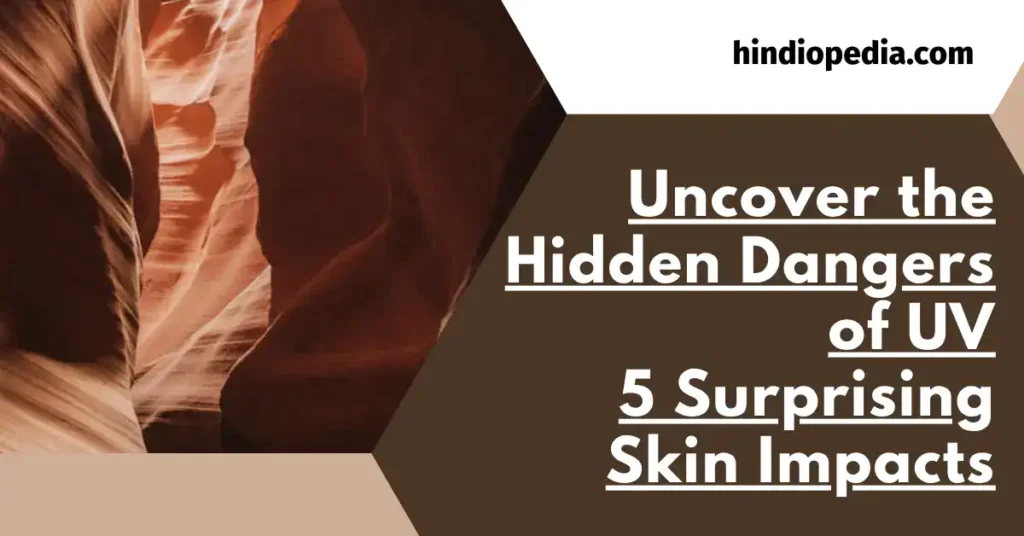5 Shocking Ways the UV Index Affects Your Skin – #3 Will Surprise You!
The sun. It’s essential for life. But it can be dangerous, especially for our skin. The UV index measures this danger. It tells us how strong the sun’s rays are. Many people ignore it. That’s a mistake. The UV index affects our skin in surprising ways. Here are five shocking effects you need to know.

1. Rapid Aging
UV rays are sneaky. They penetrate deep into your skin. Even when you can’t feel it, this causes premature aging. Think wrinkles. Fine lines. Age spots. It’s not just about looks. UV damage weakens skin structure. This makes it less elastic. Less able to heal.
A study in Clinical, Cosmetic, and Investigational Dermatology found that UV exposure is responsible for 80% of visible facial aging signs. That’s huge. It’s more than all other factors combined. Including genetics and lifestyle choices.
High UV index days speed up this process. Your skin ages faster. Even short exposures matter. A few minutes here and there add up. Over time, the damage becomes visible. And it’s hard to reverse.
2. Increased Risk of Skin Cancer:
This one’s serious. UV radiation is a known carcinogen. It damages DNA in skin cells. This can lead to mutations. These mutations can cause skin cancer. All types of skin cancer are linked to UV exposure. This includes melanoma. That’s the deadliest form.
The World Health Organization states that excessive UV exposure is the leading cause of skin cancer. The numbers are alarming. In the United States alone, more than 9,500 people are diagnosed with skin cancer every day. That’s according to the Skin Cancer Foundation.
A higher UV index means higher risk, even on cloudy days. UV rays can penetrate clouds. They can reflect off water and sand. This increases exposure and risk.
3. Immune System Suppression:
This is the surprising one. UV radiation doesn’t just affect your skin. It impacts your entire immune system. How? By suppressing it. This makes you more vulnerable. To infections. To diseases. Even to other types of cancer.
A review in Photochemistry and Photobiology explains this effect. UV exposure decreases the number and function of immune cells in the skin. It also alters the balance of cytokines. These are important signaling molecules in the immune system.
This suppression can last for days after sun exposure. It’s not just a short-term effect. Repeated exposure can lead to chronic immune suppression. This is especially concerning in areas with high UV index.
4. Eye Damage
Your skin isn’t the only target. UV rays can harm your eyes too. They can cause cataracts. Macular degeneration. Even eye cancers. The higher the UV index, the greater the risk.
The American Academy of Ophthalmology warns about this danger. They state that UV exposure increases the risk of certain eye diseases by 60%. That’s significant. And often overlooked.
The damage is cumulative. It builds up over time. You might not notice it immediately. But years of exposure can lead to serious problems. Proper eye protection is crucial. Especially on high UV index days.
5. Photosensitivity Reactions:
Some people are extra sensitive to UV light. This condition is called photosensitivity. It can cause severe skin reactions. Even with minimal sun exposure. High UV index days are particularly dangerous for these individuals.
The American Osteopathic College of Dermatology explains that photosensitivity can be triggered by certain medications. Common culprits include antibiotics. Diuretics. Even some acne treatments. It can also be caused by medical conditions. Like lupus. Or porphyria.
Symptoms can be severe. They include rashes. Blisters. Hives. In some cases, it can lead to anaphylaxis. That’s a life-threatening allergic reaction. Awareness of the UV index is crucial for people with photosensitivity.
Understanding the UV Index
The UV index is a scale. It ranges from 1 to 11+. Here’s a breakdown:
| UV Index | Risk Level | Recommended Protection |
|---|---|---|
| 1-2 | Low | Minimal |
| 3-5 | Moderate | Standard |
| 6-7 | High | Extra |
| 8-10 | Very High | Maximum |
| 11+ | Extreme | Avoid exposure |
This scale helps you understand the risk. And take appropriate action. It’s updated daily. Sometimes hourly. Checking it should be part of your routine.
Protecting Your Skin
Knowledge is power. But action is key. Here are some ways to protect yourself:
- Use sunscreen. Every day. Even when it’s cloudy. Choose broad-spectrum. SPF 30 or higher.
- Wear protective clothing. Long sleeves. Wide-brimmed hats. Sunglasses.
- Seek shade. Especially during peak hours. Usually 10 am to 4 pm.
- Check the UV index. Plan activities accordingly.
- Be extra cautious near reflective surfaces. Water. Sand. Snow.
Remember, there’s no such thing as a “safe tan”. Any change in skin color is a sign of damage.
The Role of Technology
Technology can help. There are apps that track the UV index. They can send alerts. Remind you to reapply sunscreen. Some even use your location data. To give personalized recommendations.
Wearable devices are emerging too. UV sensors in watches. Jewelry. Even clothing. These can provide real-time UV exposure data. They make protection easier. More precise.
Global Implications
UV exposure isn’t just a personal health issue. It’s a global concern. Climate change is affecting UV levels. Ozone depletion plays a role. Some regions are seeing higher UV indexes. More frequently.
The World Health Organization has a UV protection program. It aims to raise awareness. Promote protective measures. On a global scale. This highlights the seriousness of the issue.
The Bottom Line
The UV index is more than a number. It’s a crucial health indicator. It affects our skin in multiple ways. Some are obvious. Others are surprising. Understanding these effects is important for everyone.
Protection is key. But it starts with awareness. Check the UV index regularly. Take appropriate measures. Your skin will thank you. Now and in the future.
Remember, skin health is lifelong. The choices you make today matter. They affect your skin for years to come. Stay informed. Stay protected. Stay healthy.







